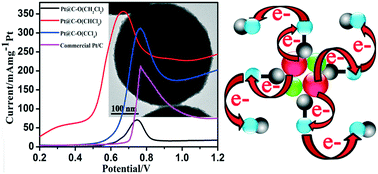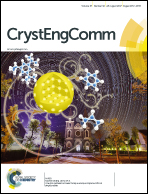Regenerated CO anti-poisoning ability by anchoring highly oxidized platinum on oxygen-functionalized carbon spheres in one-step & two-phase synthesis for methanol electro-oxidation†
Abstract
In this work, a one-step and two-phase solvothermal approach has been employed to synthesize Pt@C–O composite spheres formed by platinum (Pt) nanoparticles (NPs) anchored on oxygen-functionalized carbon spheres. The introduction of platinum(II) 2,4-pentanedionate (Pt(acac)2), benzoic acid, and chloromethane–glycerol two-phase solution is found to be significant for the formation of Pt@C–O composite nanostructures. Furthermore, the as-obtained Pt@C–O composites are found to have much more oxidized species of carbon (C–O) and platinum (Pt–O), as compared to commercial Pt/C. Results show that the Pt@C–O (CHCl3) catalyst based on the obtained Pt@C–O in a chloroform–glycerol mixture exhibits optimal electrocatalytic activity and superior carbon monoxide (CO) tolerance, which is mainly because the oxidation states of carbon and platinum cause the catalyst to regenerate during the methanol oxidation and CO anti-poisoning processes.



 Please wait while we load your content...
Please wait while we load your content...